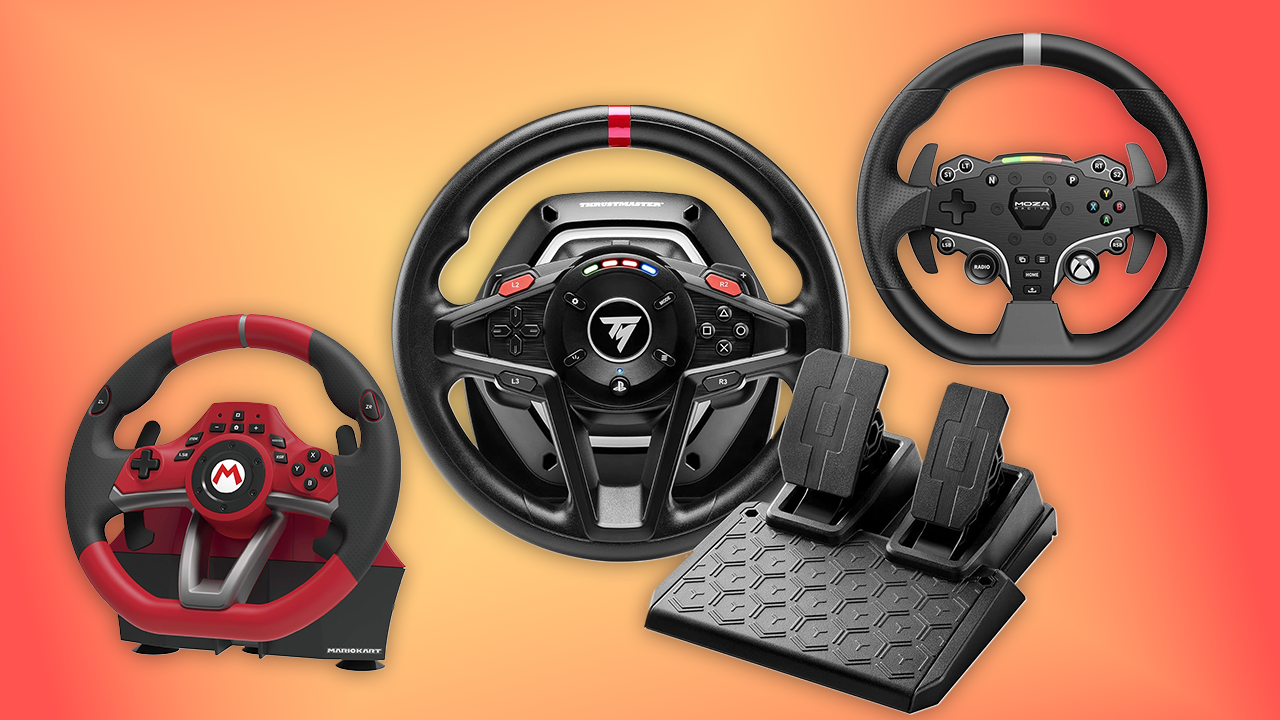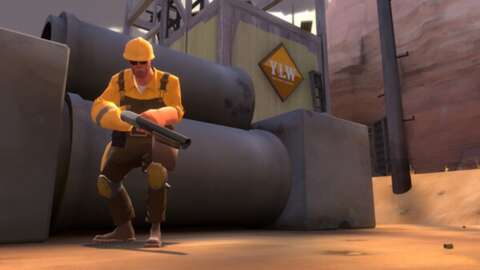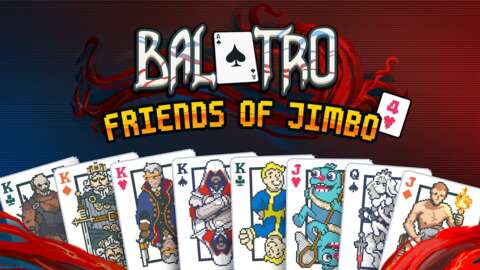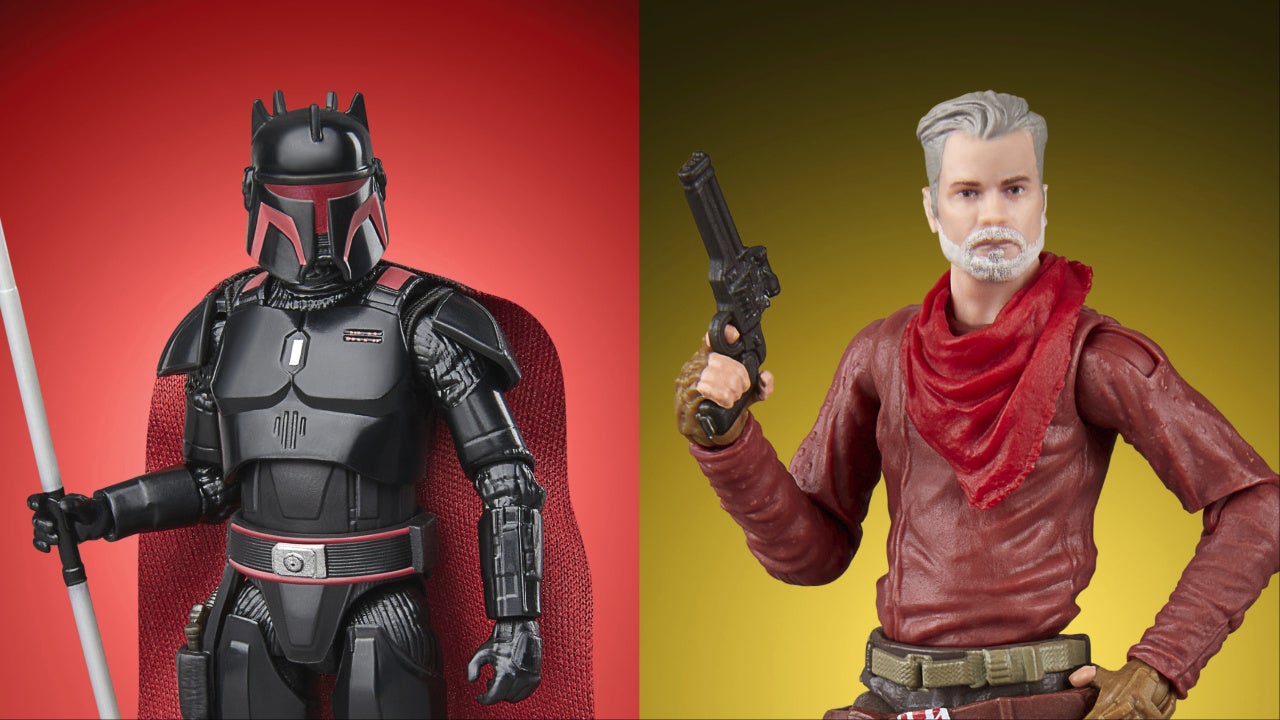
As technology rapidly marches on, the line between real-life motorsport and the racing simulations that seek to replicate them is getting thinner and thinner. It’s certainly no secret that many of the most successful drivers in real life spend a good deal of their spare time in racing simulations – and that should speak volumes about how racing hardware is getting better than ever. Of course, there also seems to be more of it than ever, and that can make choosing your first (or next) racing sim gear purchase a little tricky.
With that in mind, I’ve assembled a shortlist of 10 racing wheel suggestions for PC, Xbox Series X|S, PS5, and even Nintendo Switch. Based on how much you have available to spend (and how serious you plan on taking your sim racing), the list below should give you a little more clarity on the strengths and weaknesses of all the wisest low-price, mid-range, and high-end options available today. If you're big on racing games, a racing wheel is easily one of the most clutch gaming accessories you can buy.
TL;DR: The Best Racing Wheels
1. Thrustmaster T-128
Best Budget Wheel for PC and Xbox
The Thrustmaster T-128 is very much an entry-level sim racing product, and its pricing and build reflect that, but it still has a lot of merit as a great first step into sim racing for kids and racing fans on the tightest budgets.
The small and entirely plastic rim does feel a little toy-like (as does the small and also entirely plastic two-pedal set), but you do get real force feedback – and that’s a crucial distinction between the T-128 and lower-priced options like the T-80. The juice is absolutely not worth the squeeze on super budget options like the T-80 and its equivalents, which operate on bungee-style resistance systems with zero force feedback. If you’re thinking about buying one of those, save your money and just stay on a controller.
The T-128’s small rim diameter may seem a little dinky initially, but it’s important when a wheel base isn’t packing a huge torque number, as the closer your hands are to the centre of rotation the stronger it will feel. The T-128’s 2 Nm of peak torque is certainly modest compared to the power of its more expensive peers, but it’s still sufficient enough to communicate enough of the on-track information you’ll need to feel your car’s behavior and react intuitively.
If you do take the plunge and are having fun, the good news is the T-128 can also be augmented with add-ons, like the TH8S shifter – which is a 7-speed + reverse H-pattern shifter. The pedals can also be upgraded, so you’re not locked in to just what comes in the box. For those looking for a wheel for trucking and farming sims rather than racing, a bracket system for mounting the T-128 wheel base horizontally is also available (which also comes with a rotary spinner knob for one-handed operation).
The Thrustmaster T-128 comes in two versions: one compatible with both Xbox and PC, and one compatible with PlayStation and PC. Broadly speaking, PlayStation compatibility adds an additional premium to the RRP of a wheel, although this can vary depending on retailer pricing.
2. Logitech G-29
Best Budget Wheel for PlayStation
With the Thrustmaster T-128 more expensive on PlayStation than the Xbox version, the Logitech G-29 is a sound alternative choice in this scenario. After a decade on sale, the G-29 might seem positively geriatric, but there are at least several good reasons you can still buy new G-29s: They’re robust, they’re great bang-for-your-buck, and they remain a very reliable place to start a sim racing journey.
With a metal rim, wrapped and stitched, the G-29 does immediately feel a little less toy-like than the T-128 in the hands. The included three-pedal set is also a class above, with metal pedals and a better overall feel (a rubber stopper mounted behind the brake pedal simulates the building hydraulic force of a brake pedal). The fact that you get a clutch pedal out of the box also means you don’t also need to upgrade your pedals if you opt to add Logitech’s standalone shifter to your setup later on. Unfortunately, Logitech’s standalone shifter has a shorter throw than Thrustmaster’s TH8S shifter and it doesn’t feel as good to use.
The G-29’s core weakness, however, is that it does tend to make a bit of a racket at times – particularly when there’s a lot of force feedback information being pumped into it. They definitely clunk and rattle quite a bit. Rally gamers take heed.
Why are we recommending the G-29 over the considerably newer G-923? Well, the G-29 is essentially the exact same thing as the G-923, only without Logitech’s recent “Trueforce” technology. Trueforce is a layer of haptic feedback extracted from the physics and audio packages of certain supported racing games that delivers some extra sensations and vibrations to the wheel rim and into your hands. The result does feel richer in comparison (and the G923 bundle also replaces the rubber stopper on its brake with a progressive spring which helps hard braking firm up nicely without the stopper’s two-stage effect) but the general whine Trueforce adds does make the wheel even noisier. Unless you can find one discounted to closer to the price of a G-29, the price bump isn’t really worth it.
3. Moza R3
Best Starter Direct Drive Wheel for Xbox Series X|S and PC
Moza’s first Xbox-compatible racing wheel is the latest addition to the company’s increasingly extensive sim racing ecosystem and we've reviewed it. It’s a complete, ready-to-race set that will put you behind a direct drive wheel that’s only marginally more expensive than much older, non-direct drive bundles like the Thrustmaster T300 RS GT or TX (which boast basically the same amount of torque, but are belt-driven).
The brushed metal rim has a polyurethane wrapping that looks a little cheap but feels fine and suitably grippy during use. Importantly, the core benefit of the R3 over its belt-driven, mid-price range competitors is that it’s direct drive, so force feedback is smooth, silent, and instant. The effect really is night and day, and it’s very hard to go back to gear- or belt-driven alternatives after using direct drive.
It’s also extremely upgradable. Xbox compatibility is baked into the wheel itself (which is called the Moza ESX wheel and is now available separately) so you can move up to other wheel bases later on (like the R9 or R12, which are far more powerful, and will still attach to the same table clamp that comes with the R3). Snap on your wheel via Moza’s excellent and rigid quick release system, and bam – it’ll still work on your Xbox. The pedals can also be upgraded, although the bundled pedals are all-metal and extremely sturdy. Just keep in mind that, at this price point, resistance in the bundled pedals is provided by springs and input is determined by Hall effect sensors that are detecting the position of the pedals rather than the force you’re applying to them.
One thing to note is that Moza add-ons, like the standalone shifters and handbrake, are currently not compatible with most Xbox racing games.
4. Fanatec GT DD Pro
Best Direct Drive Wheel
Fanatec’s cheapest “Ready2Race” bundles (based around its CSL DD wheelbase) hover somewhere slightly above the price of the Moza R3 bundle, which makes the CSL DD is another good starting point when it comes to getting into the world of direct drive. There are caveats, however, like the table clamp being sold separately, and the fact that they’re… currently sold out.
Fanatec’s GT DD Pro bundles are considerably more expensive for what’s basically the same thing with PlayStation compatibility baked into the wheelbase (which, as you’ve seen, appears to add a PlayStation premium to pricing on any wheel product).
Again, due to the direct drive technology, the quality of force feedback is streets ahead of belt-driven rivals, and it’s totally quiet during operation. The GT DD boasts a totally adequate 5 Nm of torque by default, but that can be raised to 8 Nm with a boost kit for an additional cost. The all-metal, two-pedal set uses Hall effect sensors to detect the position of the pedals rather than the force you’re using, so keep in mind braking won’t feel like the real thing without an additional purchase of a load-cell brake pedal.
The GT DD’s power play, however, is that it’s probably the most elegant solution for racing enthusiasts who want the flexibility to play racing games across multiple consoles (and PC). Long story short, PlayStation compatibility is achieved via the GT DD wheelbase itself but, if you purchase and attach an Xbox-compatible Fanatec wheel rim, your whole set up becomes Xbox compatible too. This means you’ll be able to hop from Gran Turismo 7 to Forza Horizon 5 without needing to own and mount entirely separate wheel bases. Until Moza can secure PlayStation compatibility for itself, the GT DD is arguably the top all-in-one(-ish) choice.
5. Hori Mario Kart Racing Wheel Pro Deluxe
Best Nintendo Switch Racing Wheel
The Hori Mario Kart Racing Wheel Pro Deluxe is a low-end racing wheel that makes use of elastic resistance to add weight to the wheel as you turn. The effect is very toy-like but may be sufficient for kids and beginners to have some fun once they get a feel for it (which can be a little tricky at first because it doesn’t really feel anything like an actual steering wheel and it’s easy to over-correct). Reduce the rotation range if you find you’re struggling to stay in a straight line.
The pedal set is very small, but the fact that they’re naturally analog makes the pedals a step up over the strictly digital triggers on Switch Joy-Con. The selection of serious racing games may be a little slim on Switch, but this is a highlight for stuff like the excellent Grid Autosport.
“Best Nintendo Switch Racing Wheel” is an easy title to win in what’s essentially a one-horse race but, to be fair, the Nintendo Switch is not really the console of choice for racing sim connoisseurs. Either way, if you absolutely must own a Nintendo Switch wheel, choose this one over the Hori Mario Kart Mini (which is a tiny 220mm in diameter and only mounts via suction cups).
6. Thrustmaster T300 RS GT
Best Mid-Price PlayStation Racing Wheel
Like the Logitech G-29, the Thrustmaster T300 RS GT is another very old steering wheel that’s still available new today. Indeed, it’s been on sale since 2016 – and the original, non-Gran Turismo-branded T300 RS was released in 2014. That’s well before the release of Gran Turismo Sport, a game that has since come out and subsequently been delisted.
The T300 RS GT relies on belt-driven force feedback, meaning it’s not capable of the same level of nuance as you can get in (more expensive) direct drive systems, but it delivers a sturdy level of feedback without the louder clatter you get in its cheaper Logitech competitors.
The 280mm metal wheel itself is typically sized and, while the rubber coating isn’t as nice as the leather-wrapped Logitech options, it’s appropriately grippy. The included three-pedal set doesn’t feature load-cell pedals, but it does come with an effective-enough rubber stopper mod to mount behind the brake pedal and add resistance to the last moment of pedal travel.
With its advanced age (and with direct drive wheels coming down in price), the T300 RS GT is admittedly a slightly outmoded option in 2025. It is PC compatible, but it definitely shouldn’t be your first choice for PC these days considering the aggressive prices of the entry-level direct drive Moza options. However, with no direct drive options on PlayStation at its price point, the T300 RS GT remains a very serviceable choice.
7. Logitech G Pro Racing Wheel
Best Value Premium PC and Console Racing Wheel
Logitech has long made dependable racing wheels for players new to the racing simulation scene or with more modest budgets. The G29/G920 and the G923 are robust options and, as mentioned earlier, the G29 in particular has more than stood the test of time. Logitech’s G-Pro Racing Wheel, however, was new territory for the veteran racing peripheral manufacturer: a higher-end, direct drive system that far eclipses its enduringly popular but more primitive gear-driven systems.
The wheelbase of the G Pro Racing Wheel certainly isn’t as compact as alternative direct-drive options from Fanatec and Moza, and the more traditional-looking plastic case around the system does actually make it resemble old-school belt-and-pulley-type systems. However, don’t be deceived; it’s very much a direct-drive unit – and the 11 Nm of torque it has on tap is just right to meet the demands of the serious side of sim racing (10 to 12 Nm of torque is near enough the best compromise you can currently get between authentic power and pricing that isn’t outright bonkers).
As a direct drive wheel, the difference in driving feel between the G Pro and Logitech’s older models is stark. It also includes Logitech’s Trueforce haptics technology, but it comes without the extra wheelbase noise you get out of Trueforce on the G923. In the G Pro’s case, Trueforce (in supported games) is actually a pretty great boost to the value of this wheel. The rim itself shares a lot in common with other past Logitech rims, but it's a little larger, which is another tick for authenticity. The pedals are strong, too, both figuratively and literally, as they’re extremely adjustable and come with a 100kg load cell brake. The brake can also be modified to be softer to simulate street cars or much firmer to replicate race cars.
With its power and its quality of feedback, the G Pro is punching up a weight class here. The G Pro’s RRP is certainly a non-trivial amount of money (especially for the bundle which includes pedals), but it absolutely holds its own against high-end options.
8. Turtle Beach VelocityOne Race Wheel and Pedal Set
Best Value Direct Drive Plus Load Cell Pedal Bundle
For clarity, the VelocityOne Race wheel and pedal set is a first for Turtle Beach, and it probably doesn’t represent the absolute best driving feel you can get for your bucks at this price point. The sim racing market is more competitive than ever, and there are a lot of options.
We are, however, going to give the VelocityOne Race a nod in this instance for being a solid, all-inclusive bundle that would potentially set a new racer up with a direct drive wheel, load cell pedals, and a button box (which is admittedly only really useful on PC as, on Xbox, it’s only capable of duplicating the existing finite functions of an Xbox controller’s buttons). This is without any additional purchases. For perspective, you can certainly build yourself something equivalent to the VelocityOne Race – say, by buying a Moza R9 wheel base, the ESX wheel rim, and the SR-P load cell pedals and clutch add-on. This hypothetical Moza set-up would be a genuinely good investment, albeit without a button box. However, if your own margins are thin and price is an issue, the RRP of the VelocityOne Race will typically sit a fraction below the above set of individual Moza purchases (and much less than the likes of the Logitech G Pro or Thrustmaster T818, which also have three-pedal sets with load-cell brakes, but they’re an additional add-on).
The VelocityOne Race may not quite have the quality of force feedback that some of our other recommendations have but, if your only previous experience of sim racing wheels is older gear- and belt-driven bases, the difference will still be extremely striking.
9. Moza R12
Best Direct Drive Wheel Base
If you want the absolute best high-end sim racing gear available, you can drop tens of thousands of dollars on the same professional-grade sim racing equipment actual racing drivers use. Max Verstappen’s sim racing setup includes a Leo Bodnar wheelbase, which can cost well over $4,000. Shane van Gisbergen uses a Simucube 2, another high quality but hideously expensive wheelbase targeted mainly at literal motorsports professionals. The kinds of systems from these boutique sim gear outfits pack shoulder-shredding levels of torque. The Simucube 2 Ultimate, for instance, peaks at 32 Nm.
Of course, if you’re here reading this guide, you probably aren’t a professional racing driver. In this case, a more logical choice is something like the Moza R12.
The R12 is not cheap, by any stretch, but it’s a terrific wheel base that sits right in the sweet spot for price versus power. There’s little to be gained from spending almost double on Moza’s R21 if you’re only going to find yourself dialling down the peak torque so you can realistically lap with the same intensity for long periods of time. As it stands, 12 Nm of torque is enough for the R12 to layer a powerful degree of force over a spectrum of more granular sensations. As usual it’s also extremely quiet during operation.
As a wheelbase alone you do, of course, need to consider the fact that you’ll need a rim and pedals to actually make use of it – both of which will significantly increase your spend. If you already have some Moza gear but are looking for more kick, the R12 is a no brainer. However, if you’re already invested in the Thrustmaster ecosystem, the 10 Nm T818 wheelbase is a similarly priced and similarly solid choice.
10. Moza TSW Truck Wheel
Best Non-Traditional Wheel Rim
With the consistent popularity of highly-successful heavy vehicle simulators like SCS Software’s Euro Truck Simulator 2 and American Truck Simulator, it’s genuinely baffling it actually took as long as it did for a company to build a dedicated truck wheel for eastbound-and-down gamers who have a long way to go and a short time to get there.
With an aluminium four-spoke frame and wrapped in stitched leather, Moza’s TSW Truck Wheel is 400mm in diameter. This makes it extremely close to a typical real truck steering wheel, which are commonly 18 inches (approximately 450mm), so the extra immersion it adds is terrific. The width will knock out a lot of the grunt on low-torque bases, but that’s not a huge issue in the context of the sorts of games the TSW is designed for.
Either way, the result is a wheel that feels wonderfully authentic to use for heavy vehicle sims, especially when paired with Moza’s special truck wheelbase mount (which allows us to reverse mount any Moza wheelbase on the edge of surfaces so the wheel is properly positioned for trucking).
How to Choose a Racing Wheel
One of the first things you should ask yourself before investing in a racing wheel is how much do you plan on using it? If you just want something to have a little fun with every now and then that feels a bit more interesting and intuitive than a controller, an entry-level option will probably suffice. If you’re planning on diving face-first into the world of racing simulation, you can probably justify something a little more serious with sterner force feedback.
Speaking of force feedback, there are three main types:
- Gear Drive - In this case, the wheel's shaft is attached to gears that are linked to the main force feedback motor. This is the oldest type of force feedback and you’ll find it in Logitech’s G29/G920 and the G923. This is a low-cost force feedback solution but it’s also the least refined, and the noisest. Gear-driven wheels are dependable workhorses but they are notorious for being clunky and loud.
- Belt Drive - Belt-driven wheels operate in a similar way to gear-driven wheels; that is, a small motor is connected to the wheel itself via a belt, and the potency of the motor is ramped up thanks to mechanical advantage. The resulting experience feels a lot smoother than gear-driven wheels, and they are also quieter (but certainly not completely quiet). However, despite being noticeably less clunky than gear-driven wheels, they’re generally not always capable of communicating very fine types of feedback. The belt will absorb especially nuanced feedback before it reaches your hands.
- Direct Drive - Direct drive wheels are mounted directly to the motor itself, which will be larger than the ones you find in gear- and belt-driven wheels. Of course, with no gears or belt, no feedback nuance is lost and it all goes directly into your hands. Direct drive wheels are the most expensive types of sim racing gear, but the prices for direct drive wheels has steadily dropped over the past couple of years. Entry-level direct drive wheels are now available for considerably less than premium-priced belt-driven options, and they’re now absolutely the way to go if that’s within your budget.
Racing Wheel FAQ
What impact do rim sizes have on the feel of a sim racing wheel?
Small rim sizes may contribute to a slightly more toy-like feel in some wheel systems, but it is a factor in making low torque bases still feel like they have enough bite.
Why am I now slower on a racing wheel than a controller?
To be great, racing games need to be fun on a controller and a wheel. However, translating a complex racing simulation to a controller without any sort of dampening will result in a game that’s essentially too twitchy and impossible to play. When you’re playing on a controller, there are generally things going on under the hood of the simulation to take the edge off aggressive movements (to keep the car settled). Otherwise, flicking the stick from left to right would be like going from lock to lock virtually instantaneously! You may find now that being on a wheel is a little harder than you anticipated but just remember, slow is smooth and smooth is fast. The most common error a new sim racer will make is overdriving their car. Be precise and smooth with your inputs, and your feel for the limitations of your car will improve – and so will your lap times.
What are the best games to play with a racing wheel?
The list of racing games you can enjoy on a sim racing wheel is huge. If you want some serious motorsports simulation, you can’t really go past Assetto Corsa Competizione, F1 24, and Dirt Rally 2.0. Despite its initial faults, EA Sports WRC also feels terrific on a wheel – and if you can get hold of a physical copy of the now-delisted Project CARS 2, do it. If the big, mainstream car-PG collect ’em ups like Gran Turismo 7 and Forza Motorsport are more your speed, they’re also well-suited for wheels, as are the more accessible thrills of Forza Horizon 5, The Crew 2, and Wreckfest. For Nintendo Switch users, you can never really go wrong with Mario Kart 8 Deluxe.
This doesn’t feel quite right. Is my wheel a dud?
There are piles and piles of settings available within your games and on your wheels themselves. Before losing hope, consult the community for settings recommendations to dial in a driving experience you may find is exactly what you were after.
Are racing wheels worth the investment?
For those who just occasionally play driving games, you might want to save money and invest in other gaming accessories or grab a cheap wheel. However, if you’re constantly hitting the virtual open road, a great racing wheel is worth the splurge. Compared to your typical input devices, you’ll enjoy deeper immersion in games thanks to force feedback, which provides a more realistic driving experience, letting you better feel the limits of grip and performance. Your racing should improve, as a wheel offers more precision and accuracy. Just be prepared for a slight learning curve as you master the controller.
How realistic is a racing wheel?
Racing wheels can provide a realistic driving experience by reproducing accurate force feedback that you would feel by driving a real car. Of course, the quality and features of your chosen racing wheel will play a big part in the level of realism, but there are some incredible options available if you want to up your racing sim game. There is a reason that some of the most successful racing drivers around the world can be found sim racing in their spare time, and that sim racing has turned gamers into successful racing drivers.
Take Max Verstappen. In 2024, Verstappen won the iRacing Nürburgring 24 Hours sim race, then turned around, got into his Red Bull, and immediately won the real-life Imola Grand Prix. In 2021, professional Australian Supercars driver Brodie Kostecki won the series’ official sim racing championship – the Supercars Eseries – against his pro driver peers. In 2023, he won the real championship racing against many of the same drivers. Sim racing is extremely popular amongst real life racing drivers.
Moreover, sim racing has absolutely turned former gamers into actual racing drivers. In 2015, former Gran Turismo Academy winners Wolfgang Reip and Florian Strauss, alongside Japanese Formula 3 and Super GT driver Katsumasa Chiyo, won the 2015 Bathurst 12 Hour at Australia’s world-famous Mount Panorama circuit. They aren’t the only ones the GT Academy has uncovered, either. Hell, they even made a whole (slightly flawed) movie about it.
Luke is a Senior Editor on the IGN reviews team. You can track him down on Bluesky @mrlukereilly to ask him things about stuff.















